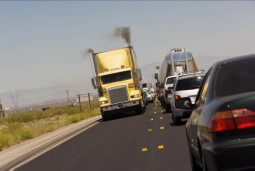EMBARGOED FOR RELEASE | August 31, 2011
Cutting soot emissions: Fastest, most economical way to slow global warming
Note to journalists: Please report that this research was presented at a meeting of the American Chemical Society.
DENVER, Aug. 31, 2011 — A new study of dust-like particles of soot in the air — now emerging as the second most important — but previously overlooked — factor in global warming provides fresh evidence that reducing soot emissions from diesel engines and other sources could slow melting of sea ice in the Arctic faster and more economically than any other quick fix, a scientist reported here today.
In a presentation at the 242nd National Meeting & Exposition of the American Chemical Society (ACS), Mark Z. Jacobson, Ph.D., cited concerns that continued melting of sea ice above the Arctic Circle will be a tipping point for the Earth's climate, a point of no return. That’s because the ice, which reflects sunlight and heat back into space, would give way to darker water that absorbs heat and exacerbates warming. And there is no known way to make the sea refreeze in the short term.
Jacobson’s calculations indicate that controlling soot could reduce warming above parts of the Arctic Circle by almost 3 degrees Fahrenheit within 15 years. That would virtually erase all of the warming that has occurred in the Arctic during the last 100 years.
Media Contact
During the meeting, Aug. 25-Sept. 1, the contacts can be reached at: 303-228-8532
Michael Bernstein
202-872-6042
m_bernstein@acs.org
Michael Woods
202-872-6293
m_woods@acs.org
“No other measure could have such an immediate effect,” said Jacobson, who is with Stanford University. “Soot emissions are second only to carbon dioxide (CO2) in promoting global warming, but its effects have been underestimated in previous climate models. Consequently, soot’s effect on climate change has not been adequately addressed in national and international global warming legislation. Soot emissions account for about 17 percent of global warming, more than greenhouse gases like methane. Soot’s contribution, however, could be reduced by 90 percent in 5-10 years with aggressive national and international policies.”
Soot or “black carbon” consists of particles, nearly invisible on an individual basis, released in smoke from combustion of fossil fuels and biofuels. Major sources include exhaust from diesel cars, buses, trucks, ships, aircraft, agricultural machines, construction equipment and the wood/animal dung fires that hundreds of millions of people in developing countries use for used for cooking and heating. Black carbon particles become suspended in the atmosphere and absorb sunlight, just like a black t-shirt on a sunny day. The particles then radiate that heat back into the air around it. Black carbon also can absorb light reflected from Earth's surface, which helps make it such a potent warming agent.
The good news is that decreasing soot could have a rapid effect, Jacobson said. Unlike carbon dioxide, which remains in the atmosphere for years, soot disappears within a few weeks, so that there is no long-term reservoir with a continuing warming effect. And the technology for controlling black carbon, unlike that for controlling CO2, already is available at relatively modest cost. Diesel particulate filters, for instance, can remove soot from car and truck exhaust. Government and other agencies also are trying to introduce low-soot cookstoves in developing countries. “Converting gasoline- and diesel-burning cars and trucks to electric or hydrogen vehicles and reducing emissions from diesel generators could have an immediate effect on warming,” according to Jacobson.
Jacobson, who developed the first detailed climate model to include the global effects of soot, reported on use of the model to gain new insights into the effects of soot particles trapped inside and between the water droplets that make up clouds. Previous research on black carbon and climate overlooked that topic. Jacobson said the information is important because black carbon within clouds makes the clouds “burn off” and disappear over heavily polluted urban and other areas. Climate models that ignore this “cloud absorption” phenomenon underestimate the effects of black carbon on climate.
###

diesel trucks and burning wood and dung is the
fastest way to help slow global warming,
scientists say.


